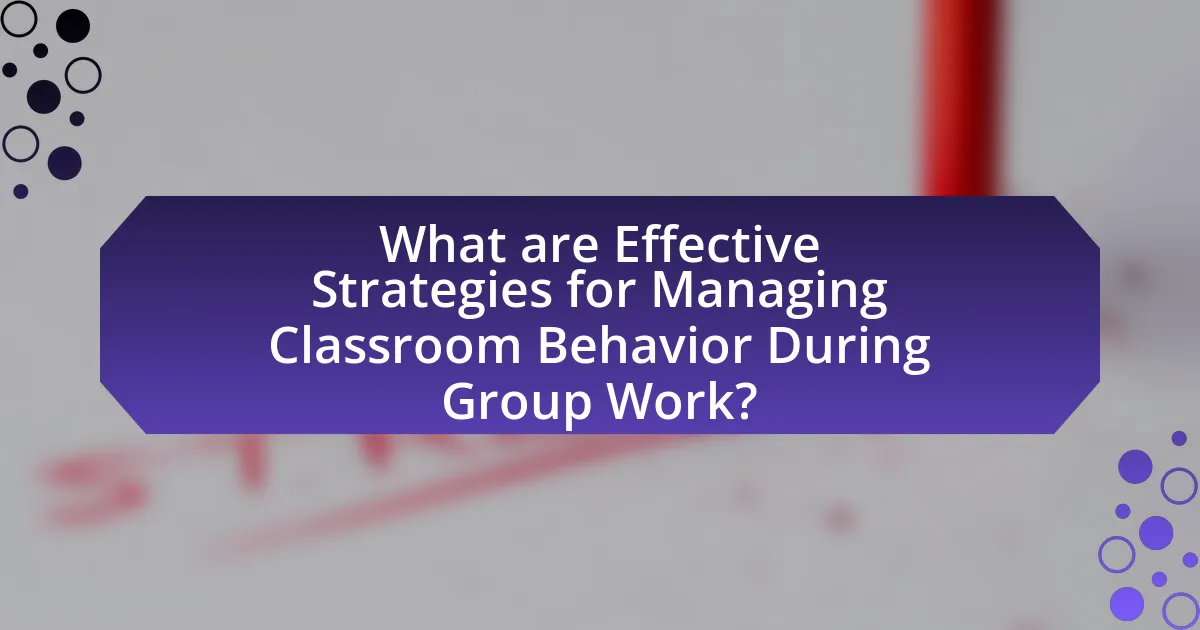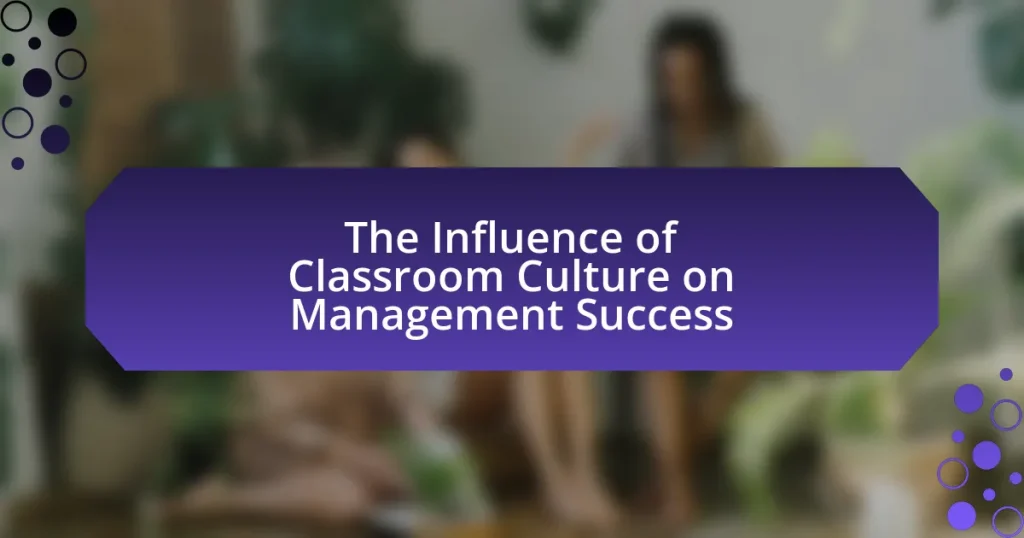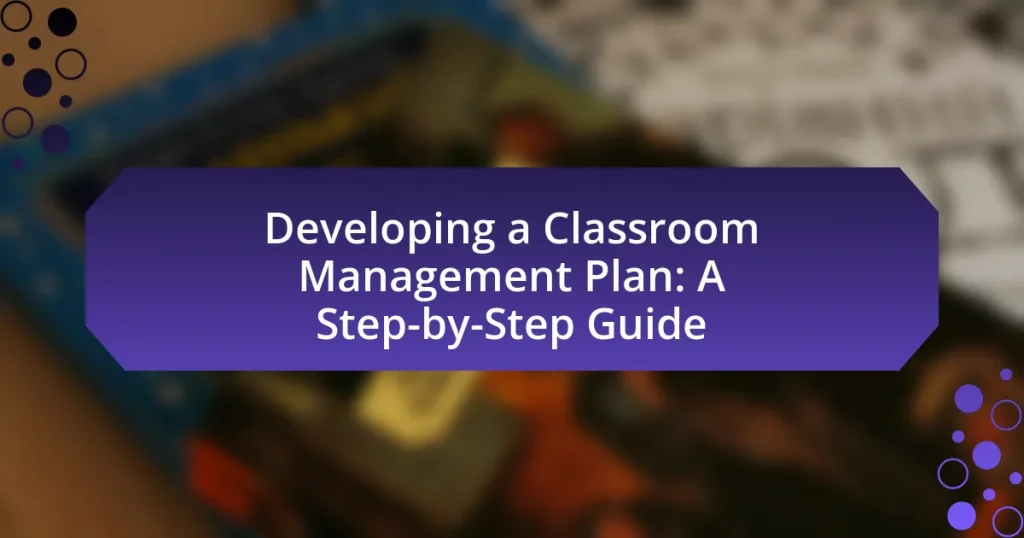The article focuses on effective strategies for managing classroom behavior during group work, emphasizing the importance of establishing clear expectations, monitoring group dynamics, and assigning structured roles. It outlines methods for teachers to create a positive classroom environment, including the use of visual aids and fostering teacher-student rapport. Additionally, the article addresses common challenges such as off-task behavior and unequal participation, providing practical tips for intervention and promoting peer accountability. Research findings support the effectiveness of these strategies in enhancing student engagement and collaboration, ultimately leading to improved learning outcomes.

What are Effective Strategies for Managing Classroom Behavior During Group Work?
Effective strategies for managing classroom behavior during group work include establishing clear expectations, monitoring group dynamics, and providing structured roles. Establishing clear expectations involves outlining specific behavioral norms and academic goals at the outset, which helps students understand what is required of them. Monitoring group dynamics is crucial; teachers should circulate among groups to observe interactions and intervene when necessary to redirect off-task behavior. Providing structured roles, such as assigning a leader, recorder, or presenter, can help maintain focus and accountability within the group. Research indicates that classrooms with defined roles and active teacher engagement see a reduction in disruptive behavior and an increase in student collaboration (Johnson & Johnson, 2014, Educational Psychology).
How can teachers establish clear expectations for group work behavior?
Teachers can establish clear expectations for group work behavior by explicitly outlining roles, responsibilities, and behavioral norms at the beginning of the project. This can be achieved through collaborative discussions where students contribute to the creation of a group contract that details acceptable behaviors, communication protocols, and conflict resolution strategies. Research indicates that when students are involved in setting these expectations, they are more likely to adhere to them, as demonstrated in studies showing increased engagement and accountability in group settings.
What specific rules should be communicated to students?
Students should be communicated specific rules such as respecting others, staying on task, and contributing equally to group work. Respecting others includes listening when someone else is speaking and valuing diverse opinions, which fosters a collaborative environment. Staying on task ensures that the group remains focused on the assignment, preventing distractions that can derail progress. Contributing equally means that each student should participate actively, which promotes accountability and teamwork. These rules are essential for maintaining a productive and respectful classroom atmosphere during group activities.
How can visual aids support behavior expectations?
Visual aids can support behavior expectations by providing clear, consistent visual representations of desired behaviors and rules. These aids, such as charts, posters, or digital displays, serve as constant reminders for students, reinforcing the behavioral standards set in the classroom. Research indicates that visual aids enhance understanding and retention of information, making it easier for students to recall and adhere to behavior expectations. For instance, a study published in the Journal of Educational Psychology found that classrooms utilizing visual behavior charts saw a 25% increase in on-task behavior among students, demonstrating the effectiveness of visual aids in promoting positive behavior during group work.
Why is it important to create a positive classroom environment during group work?
Creating a positive classroom environment during group work is essential because it fosters collaboration, enhances student engagement, and improves learning outcomes. A supportive atmosphere encourages students to express their ideas freely, leading to more effective teamwork and problem-solving. Research indicates that positive classroom environments can increase student motivation and participation, as evidenced by a study published in the Journal of Educational Psychology, which found that students in supportive settings showed higher levels of engagement and achievement. Therefore, establishing a positive environment is crucial for maximizing the benefits of group work in educational settings.
How does a positive environment influence student interactions?
A positive environment significantly enhances student interactions by fostering collaboration and open communication. In such an environment, students feel safe to express their ideas and opinions, which encourages participation and teamwork. Research indicates that classrooms characterized by supportive relationships and mutual respect lead to increased student engagement and improved academic outcomes. For instance, a study by the University of California found that students in positive classroom climates exhibited higher levels of cooperation and lower instances of conflict, demonstrating the direct impact of a nurturing atmosphere on peer interactions.
What role does teacher-student rapport play in managing behavior?
Teacher-student rapport plays a crucial role in managing behavior by fostering a positive classroom environment that encourages engagement and reduces disruptions. When teachers establish strong relationships with students, it enhances trust and communication, leading to increased motivation and cooperation. Research indicates that positive teacher-student relationships correlate with lower levels of behavioral issues; for instance, a study published in the Journal of Educational Psychology found that students who felt supported by their teachers were less likely to exhibit disruptive behaviors. This rapport not only helps in preventing misbehavior but also facilitates effective conflict resolution, as students are more likely to respond positively to guidance from teachers they respect and feel connected to.
What techniques can be used to monitor group dynamics effectively?
To monitor group dynamics effectively, techniques such as direct observation, structured feedback, and the use of group roles can be employed. Direct observation allows educators to assess interactions and engagement levels in real-time, providing insights into group behavior. Structured feedback, through tools like surveys or reflection sessions, enables participants to express their experiences and perceptions, fostering awareness of group dynamics. Assigning specific roles within the group, such as facilitator or recorder, can also clarify responsibilities and enhance accountability, leading to improved collaboration. These techniques are supported by research indicating that active monitoring and structured roles contribute to more effective group interactions and learning outcomes.
How can teachers use observation to identify potential issues?
Teachers can use observation to identify potential issues by closely monitoring student interactions and behaviors during group work. This method allows educators to detect signs of disengagement, conflict, or misunderstanding among students. For instance, observing body language, participation levels, and communication patterns can reveal if certain students are dominating discussions or if others are feeling excluded. Research indicates that effective observation can lead to timely interventions, as teachers can address issues before they escalate, thereby fostering a more collaborative and productive learning environment.
What tools can assist in tracking student engagement during group work?
Tools that can assist in tracking student engagement during group work include digital platforms like Google Classroom, Edmodo, and ClassDojo. These tools provide features such as real-time feedback, participation tracking, and analytics on student interactions. For instance, Google Classroom allows teachers to monitor student submissions and comments, while ClassDojo offers a point system to reward engagement and collaboration. Research indicates that using such tools can enhance accountability and foster a more interactive learning environment, as they facilitate immediate insights into student participation levels.

What are Common Challenges in Managing Classroom Behavior During Group Work?
Common challenges in managing classroom behavior during group work include off-task behavior, unequal participation, and conflicts among students. Off-task behavior often arises when students become distracted by social interactions or unrelated activities, which can hinder the group’s productivity. Unequal participation occurs when some students dominate discussions while others remain passive, leading to frustration and disengagement. Conflicts may arise due to differing opinions or personalities, disrupting the collaborative environment. Research indicates that these challenges can significantly impact group dynamics and learning outcomes, emphasizing the need for effective management strategies to address them.
What types of disruptive behaviors are commonly observed in group settings?
Commonly observed disruptive behaviors in group settings include talking out of turn, dominating conversations, disengagement, and inappropriate humor. Talking out of turn disrupts the flow of discussion and can lead to frustration among group members. Dominating conversations prevents equal participation, which can hinder collaboration and group cohesion. Disengagement, characterized by lack of participation or attention, negatively impacts group dynamics and productivity. Inappropriate humor can create discomfort or conflict, diverting focus from the task at hand. These behaviors can significantly affect the effectiveness of group work and the overall learning environment.
How can off-task behavior be identified and addressed?
Off-task behavior can be identified through direct observation of students’ engagement levels and by monitoring their focus on assigned tasks. Teachers can address off-task behavior by implementing structured group work protocols, such as setting clear expectations and using time management techniques. Research indicates that structured group activities can enhance student focus; for instance, a study by Johnson and Johnson (2014) found that cooperative learning strategies significantly reduce off-task behavior by promoting accountability among group members.
What strategies can mitigate conflicts among group members?
Effective strategies to mitigate conflicts among group members include establishing clear communication, setting defined roles, and promoting collaborative problem-solving. Clear communication ensures that all members understand expectations and can express concerns openly, reducing misunderstandings. Defined roles help clarify responsibilities, minimizing overlap and potential friction. Collaborative problem-solving encourages members to work together to find solutions, fostering a sense of teamwork and shared purpose. Research indicates that groups with established communication norms and defined roles experience fewer conflicts, as these practices enhance mutual respect and understanding among members.
How can teachers respond to challenging behaviors without disrupting the group?
Teachers can respond to challenging behaviors without disrupting the group by implementing proactive strategies such as non-verbal cues, private discussions, and positive reinforcement. Non-verbal cues, like a raised hand or eye contact, can redirect a student’s attention without interrupting the flow of the lesson. Private discussions allow teachers to address the behavior discreetly, minimizing embarrassment for the student and maintaining group focus. Positive reinforcement encourages desired behaviors by acknowledging and rewarding students who are following the rules, which can motivate others to do the same. Research indicates that these strategies can effectively reduce disruptions and promote a positive classroom environment, as highlighted in studies on classroom management techniques.
What are effective intervention strategies for immediate issues?
Effective intervention strategies for immediate issues in classroom behavior during group work include establishing clear expectations, implementing proximity control, and utilizing non-verbal cues. Establishing clear expectations involves outlining specific behavioral norms and consequences at the beginning of group activities, which research shows can significantly reduce disruptions (Simonsen et al., 2010). Proximity control, where the teacher moves closer to off-task students, has been proven to redirect attention and minimize distractions effectively (Emmer & Evertson, 2013). Additionally, non-verbal cues, such as hand signals or eye contact, can quickly communicate expectations without interrupting the flow of group work, enhancing engagement and focus (Marzano, 2007). These strategies are supported by evidence indicating their effectiveness in maintaining a productive classroom environment.
How can teachers provide constructive feedback to students exhibiting poor behavior?
Teachers can provide constructive feedback to students exhibiting poor behavior by using specific, actionable language that focuses on the behavior rather than the student. This approach helps students understand the impact of their actions and encourages positive change. For example, instead of saying “You are disruptive,” a teacher might say, “When you talk while others are speaking, it makes it hard for everyone to focus.” This method emphasizes the behavior and its consequences, fostering a more supportive learning environment. Research indicates that specific feedback can lead to improved student behavior and engagement, as it clarifies expectations and promotes accountability.

What Best Practices Can Enhance Behavior Management During Group Work?
Establishing clear expectations is a best practice that can significantly enhance behavior management during group work. When students understand the specific roles, responsibilities, and behavioral standards expected of them, they are more likely to engage positively and collaboratively. Research indicates that clearly defined guidelines can reduce disruptive behavior by up to 30%, as students feel more accountable for their actions within the group setting. Additionally, implementing regular check-ins and providing constructive feedback during group activities can further reinforce positive behavior and keep students focused on their tasks.
How can collaborative learning techniques improve behavior management?
Collaborative learning techniques can improve behavior management by fostering a sense of community and accountability among students. When students work together, they develop social skills, enhance communication, and learn to resolve conflicts, which can lead to a more positive classroom environment. Research indicates that collaborative learning promotes engagement and reduces disruptive behavior, as students are more invested in their peers’ success and are motivated to maintain a conducive learning atmosphere. For instance, a study by Johnson and Johnson (2009) found that cooperative learning strategies significantly decreased behavioral issues in classrooms by encouraging mutual support and shared responsibility.
What are the benefits of assigning specific roles within groups?
Assigning specific roles within groups enhances accountability and improves collaboration. When individuals have defined responsibilities, they are more likely to engage actively and contribute effectively to the group’s objectives. Research indicates that role assignment can lead to increased productivity, as each member understands their tasks and how they fit into the larger goal. For instance, a study published in the “Journal of Educational Psychology” by Johnson and Johnson (2014) found that structured roles in group settings resulted in higher levels of participation and satisfaction among students. This structured approach minimizes confusion and conflict, fostering a more organized and efficient group dynamic.
How can peer accountability be fostered among students?
Peer accountability among students can be fostered by implementing structured group roles and responsibilities. Assigning specific tasks to each group member encourages ownership of their contributions, which enhances commitment to the group’s success. Research indicates that when students are held accountable for their roles, such as through peer evaluations or group assessments, they are more likely to engage actively and support one another in achieving common goals. For instance, a study published in the Journal of Educational Psychology found that students who participated in peer assessment reported higher levels of motivation and accountability, leading to improved group performance.
What role does reflection play in managing classroom behavior?
Reflection plays a crucial role in managing classroom behavior by enabling educators to assess and adjust their teaching strategies based on student interactions and responses. This process allows teachers to identify patterns of behavior, understand the underlying causes of disruptions, and implement targeted interventions. Research indicates that reflective practices, such as journaling or peer discussions, can enhance teachers’ awareness of their classroom dynamics, leading to improved behavior management outcomes. For instance, a study by Schön (1983) emphasizes that reflective practice fosters professional growth and effective decision-making in educational settings, ultimately contributing to a more conducive learning environment.
How can students be encouraged to reflect on their group work experiences?
Students can be encouraged to reflect on their group work experiences by implementing structured reflection activities, such as guided discussions or reflective journals. These activities prompt students to analyze their contributions, group dynamics, and learning outcomes, fostering deeper understanding. Research indicates that structured reflection enhances critical thinking and self-assessment skills, which are essential for personal and academic growth. For instance, a study by Moon (2004) highlights that reflective practices in educational settings lead to improved learning outcomes and greater engagement in group activities.
What methods can be used to facilitate group discussions about behavior?
Methods to facilitate group discussions about behavior include structured dialogue, role-playing, and the use of discussion prompts. Structured dialogue encourages participants to share their thoughts in an organized manner, ensuring that all voices are heard and respected. Role-playing allows individuals to experience different perspectives, fostering empathy and understanding of various behaviors. Discussion prompts, such as open-ended questions, stimulate critical thinking and guide conversations toward specific behavioral topics. Research indicates that these methods enhance engagement and promote a deeper understanding of behavioral dynamics in group settings.
What practical tips can teachers implement to manage behavior effectively during group work?
Teachers can manage behavior effectively during group work by establishing clear expectations and roles for each student. Setting specific guidelines helps students understand their responsibilities and the behavior expected of them, which can reduce disruptions. Additionally, teachers should monitor group dynamics actively, providing immediate feedback and support to keep students on task. Research indicates that structured group work, where roles are assigned, leads to higher engagement and fewer behavioral issues (Johnson & Johnson, 2014). Implementing regular check-ins allows teachers to address any emerging conflicts or off-task behavior promptly, fostering a more productive learning environment.



